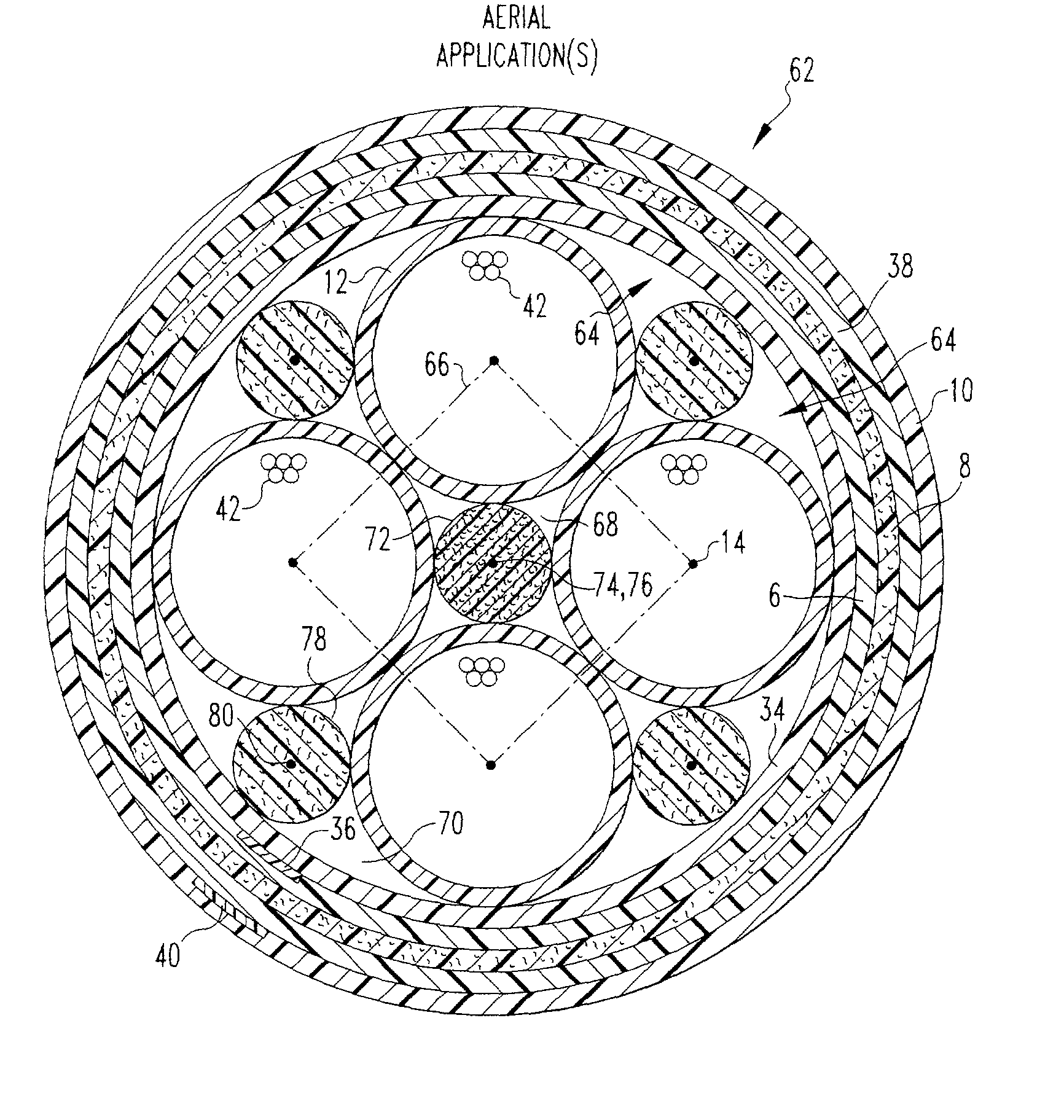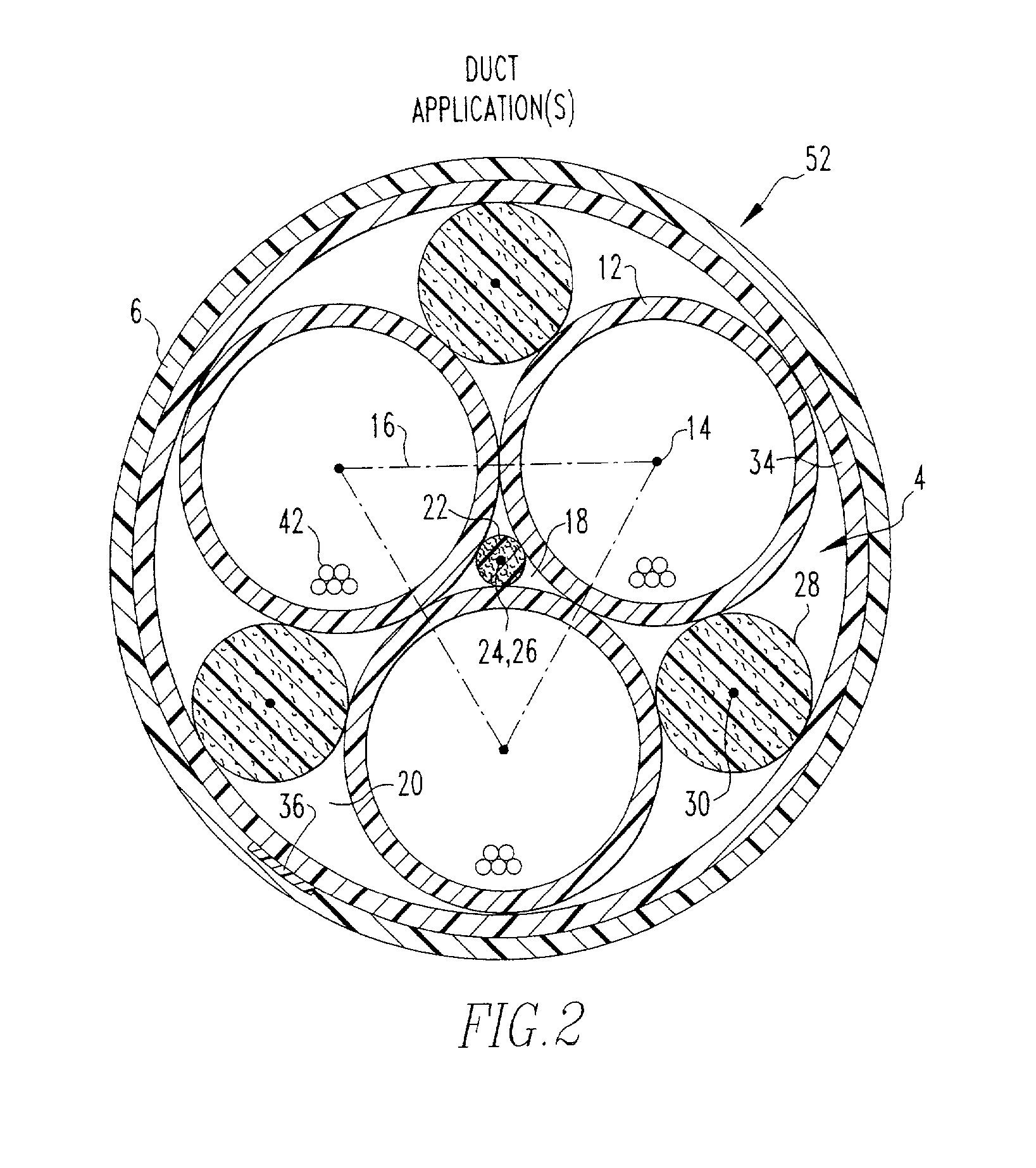Optical fiber cable assembly with interstitial support members
- Summary
- Abstract
- Description
- Claims
- Application Information
AI Technical Summary
Benefits of technology
Problems solved by technology
Method used
Image
Examples
first embodiment
[0022] With reference to FIG. 1, a first embodiment optical fiber cable assembly 2 designed for aerial applications includes an optical core 4 surrounded by an inner jacket 6, a strenght layer 8 and an outer jacket 10. Optical core 4 includes three hollow, elongated and cylindrical buffer tubes 12 arranged with their axes 14 extending in the same direction. When viewed from an end of optical core 4, the axis of each buffer tube 12 is positioned at a comer of an imaginary triangle 16 with the outside diameter of each buffer tube 12 tangent to the two other buffer tubes 12.
[0023] Buffer tubes 12 define therebetween a first, central interstitial space 18 and a plurality of second, outer interstitial spaces 20. More specifically, each pair of adjacent buffer tubes 12 define therebetween on a side thereof opposite first, central interstitial space 18 one of the second, outer interstitial spaces 20.
[0024] A central, elongated outer interstitial member 22 is received in first, central inte...
second embodiment
[0036] With reference to FIG. 2 and with continuing reference to FIG. 1, a second embodiment optical fiber cable assembly 52 designed for application in ducts, premises, conduits, raceways, and the like (hereinafter "duct applications"), has the same configuration of optical core 4 as optical fiber cable assembly 2. However, since optical fiber cable assembly 52 is designed for duct applications, outer jacket 10, layer 38 and strength layer 8 in optical fiber cable assembly 2 can be omitted in optical fiber cable assembly 52 whereupon inner jacket 6 becomes the outer jacket. Other than these omissions, optical fiber cable assembly 52 can be the same as optical fiber cable assembly 2.
third embodiment
[0037] With reference to FIG. 3, and with continuing reference to FIG. 1, a third embodiment optical fiber cable assembly 62 has an optical core 64 that is surrounded by inner jacket 6, strength layer 8, outer jacket 10 and layers 34 and 38 of Mylar tape and / or polyester binder in the manner described above in connection with optical fiber cable assembly 2. Optical core 64, however, has four buffer tubes 12 arranged with their axes extending in the same direction. When viewed from an end of optical core 64, the axis 14 of each buffer tube 12 is positioned at a corner of an imaginary square 66, with the outside diameter of each buffer tube 12 tangent to two other buffer tubes 12.
[0038] In optical core 64, buffer tubes 12 define therebetween a first, central interstitial space 68 and a plurality of second, outer interstitial spaces 70. More specifically, in optical core 64, each pair of adjacent buffer tubes 12 define therebetween on a side thereof opposite first, central interstitial...
PUM
 Login to View More
Login to View More Abstract
Description
Claims
Application Information
 Login to View More
Login to View More - R&D
- Intellectual Property
- Life Sciences
- Materials
- Tech Scout
- Unparalleled Data Quality
- Higher Quality Content
- 60% Fewer Hallucinations
Browse by: Latest US Patents, China's latest patents, Technical Efficacy Thesaurus, Application Domain, Technology Topic, Popular Technical Reports.
© 2025 PatSnap. All rights reserved.Legal|Privacy policy|Modern Slavery Act Transparency Statement|Sitemap|About US| Contact US: help@patsnap.com



